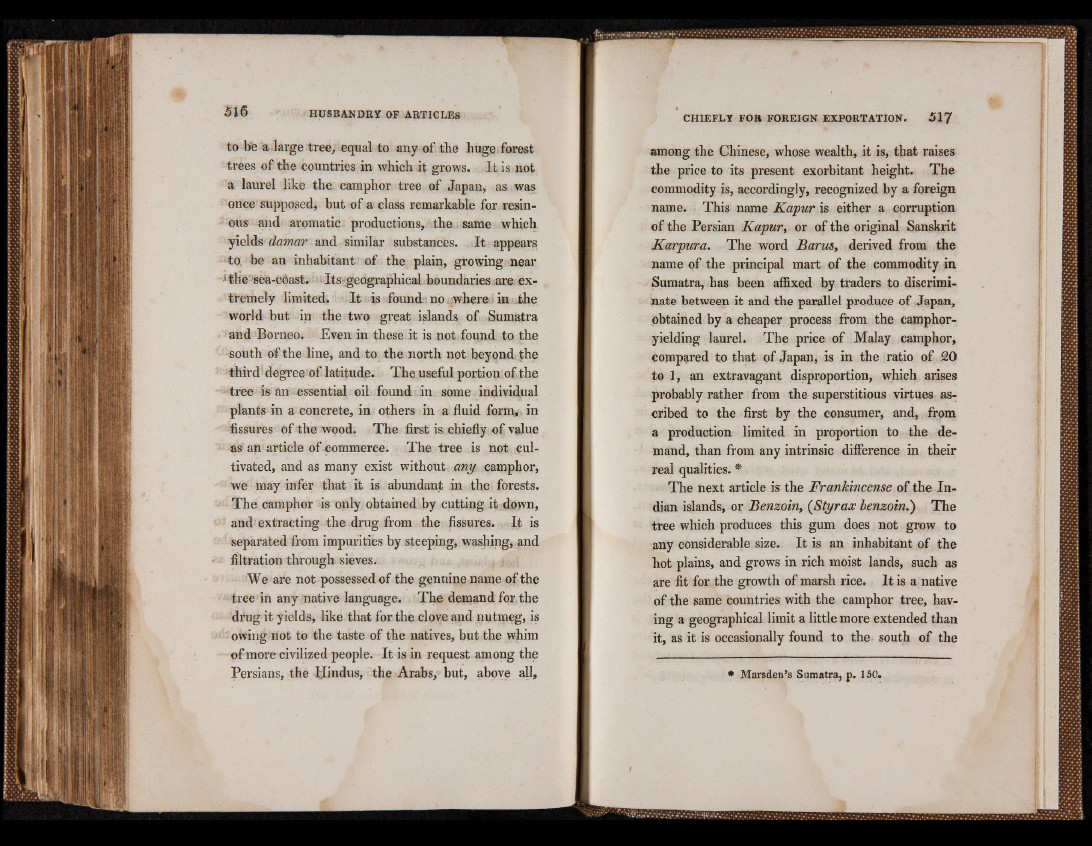
to be a large tree, equal to any of the huge forest
trees of the countries in which it grows. It is not
a laurel like the camphor tree of Japan, as was
once supposed, but of a class remarkable for resinous
and aromatic productions, the same which
yields damar and similar substances. It appears
to be an inhabitant of the plain, growing near
1 the sea-coast. » Its-geographical boundaries are extremely
limited. It is found no where in Jthe
world but in the two great islands of Sumatra
and Borneo, Even in these it is not found to the
south of the line, and to the north not beyond the
third degree of latitude. The useful portion of the
tree is an essential oil found in some individual
plants in a concrete, in others in a fluid form, in
fissures of the wood. The first is chiefly of value
as an article of commerce. The tree is not cultivated,
and as many exist without any camphor,
we may infer that it is abundant in the forests.
The camphor is only obtained by cutting it down,
and extracting the drug from the fissures. > It is
separated from impurities by steeping, washing, and
filtration through sieves.
We are not possessed of the genuine name of the
tree in any native language. The demand for the
drug it yields, like that for the clove and nutmeg, is
owing not to the taste of the natives, but the whim
of more civilized people. It is in request among the
Persians, the IJindus, the Arabs, but, above all,
among the Chinese, whose wealth, it is, that raises
the price to its present exorbitant height. The
commodity is, accordingly, recognized by a foreign
name. This name Kapur is either a corruption
of the Persian Kapur, or of the original Sanskrit
Karpura. The word Barus, derived from the
name of the principal mart of the commodity in
Sumatra, has been affixed by traders to discriminate
between it and the parallel produce of Japan,
obtained by a cheaper process from the camphor-
yielding laurel. The price of Malay camphor,
compared to that of Japan, is in the ratio of 20
to 1, an extravagant disproportion, which arises
probably rather from the superstitious virtues ascribed
to the first by the consumer, and, from
a production limited in proportion to the demand,
than from any intrinsic difference in their
real qualities. *
The next article is the Frankincense of the Indian
islands, or Benzoin, {Styrax benzoin.) The
tree which produces this gum does not grow to
any considerable size. It is an inhabitant of the
hot plains, and grows in rich moist lands, such as
are fit for the growth of marsh rice. It is a native
of the same countries with the camphor tree, having
a geographical limit a little more extended than
it, as it is occasionally found to the south of the
* Marsden’s Sumatra, p. 150.